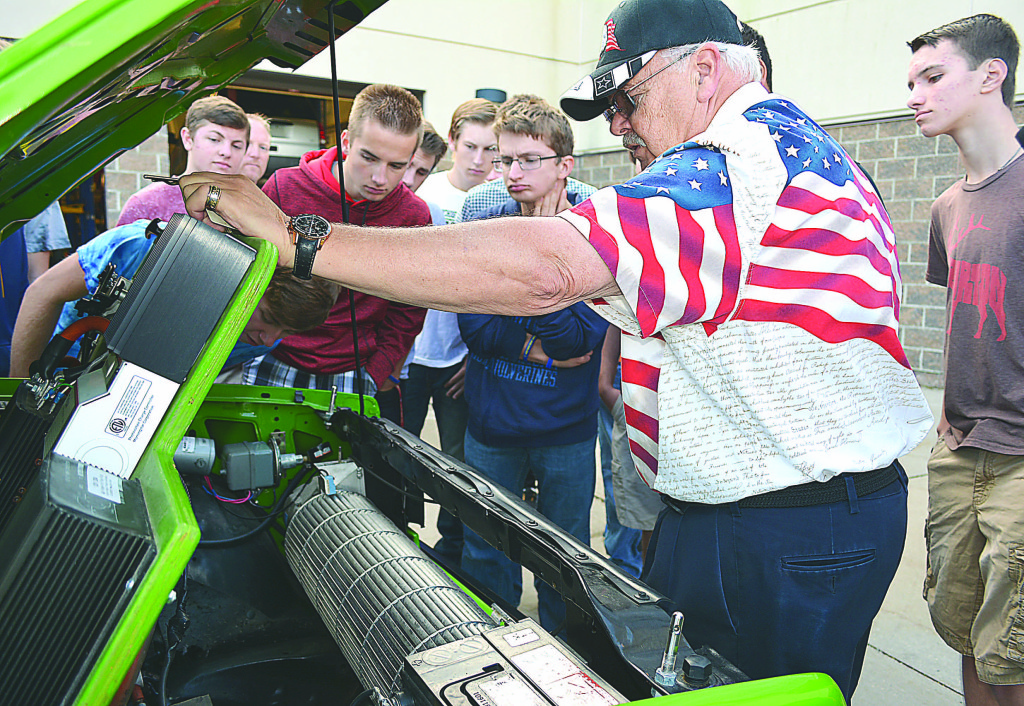
Move over, Tesla. Go charge yourself, Volt.
Make way for the Warnke.
On Tuesday, students in Oxford High School’s Auto Technology 2 and 3 classes learned all about the electric vehicle designed and built by Bob Warnke and his former company, Warnke Tool.
“You have to see it to believe it,” said OHS auto instructor Dan Balsley.
The 72-year-old Oxford resident transformed a 1987 Chevrolet S-10 pickup truck into a pure-electric vehicle that runs on batteries and the wind.
“We now call it a Chevy E-10 because it’s electric,” said Warnke, who owned and operated Warnke Tool, located at 3287 Metamora Rd., for 38 years.
The truck’s color is green to denote its eco-friendly nature and it bears a license plate on the front that reads, “NO GAS1.”
“We built it five years ago as an experiment,” Warnke explained. “We were low on work at my business and I had toolmakers there that I didn’t want to lay off.”
Warnke gave his employees a choice between being idle and “doing something worthwhile.”
“They chose to stick around and help build this,” he said. “We had a lot of fun doing it.”
Outside, it looks like an ordinary pickup truck. “If it passed you on the road, you’d have no idea there’s something different about it,” Balsley said.
But sneak a peek inside and it’s nothing like the gas-powered vehicles that have ruled America’s roads for more than a century.
“There isn’t really much that he saved except for the frame and body,” Balsley said.
Beneath the flatbed are 24 6-volt, deep-cycle, golf cart batteries and a charger.
“That’s what runs the motor,” Warnke said. “The truck runs on 144 volts.”
The traditional internal combustion engine was removed and replaced with a 32-horsepower electric motor.
“It will do 50 miles an hour,” Warnke said.
OHS junior Kyle Kalbfleisch took it for a test drive in the parking lot.
“It had a lot of zip to it,” he said. “I was pretty surprised when I pushed (down) very slightly on the pedal and it was moving.”
Warnke’s E-10 can travel a distance of about 40 miles on a single charge. The batteries are rechargeable. All that’s required is a place to plug in.
“You know what that thing really is? It’s an overgrown golf cart,” Warnke said.
A 12-volt battery powers the truck’s accessories, such as windshield wipers, lights, radio and heater. To help keep this battery charged, the E-10 relies assistance from the wind.
A squirrel cage fan, which basically looks like a hamster wheel, is located where the truck’s grill should be. As the vehicle goes forward, the wind spins the fan, which in turn, powers a WindBlue alternator that charges the 12-volt battery.
Because it’s a pure-electric vehicle, it doesn’t have all the typical engine noise produced by its gas-powered cousins. With the exception of an electrical whine, Balsley said, “It glides along without any noise.”
Warnke said the whine is only audible when the truck is going slow. It disappears once the vehicle picks up speed.
“You’re not hearing anything, except the wind going by you,” he said.
For a guy who’s been working on gas-powered vehicles and teaching others about them most of his life, Balsley finds the E-10’s quietness a bit disconcerting. “It’s still a little spooky for me,” he said.
About $28,000 was spent building the E-10. Warnke spent $2,000 in batteries alone.
During its time with Warnke, it won a few awards at various car shows.
Now, it’s the property of the OHS auto program. Warnke donated the truck in the hopes that it would not only help educate students, but also fire their imaginations.
“I want to motivate them,” he said. “We’re going to encourage them to think outside the box.”
“It’s going to open up their eyes and their minds to electric vehicles – how they work, what’s involved,” Balsley noted.
“I’d love to look at it more and learn more about it,” Kalbfleisch said.
Warnke would like to see students tear it apart, learn how it works and improve upon it with their own innovations.
Balsley is considering ways to integrate the E-10 into his lesson plans.
“This is a new experience for me, so we’ll have to see how and where it fits,” he said.
Given electric cars seem to be the wave of the future, Warnke believes it’s important for students to start exploring them in the classroom. “They’re the thing right now,” he said. “Everybody and their brother is trying to build a good electric vehicle.”

Leave a Reply